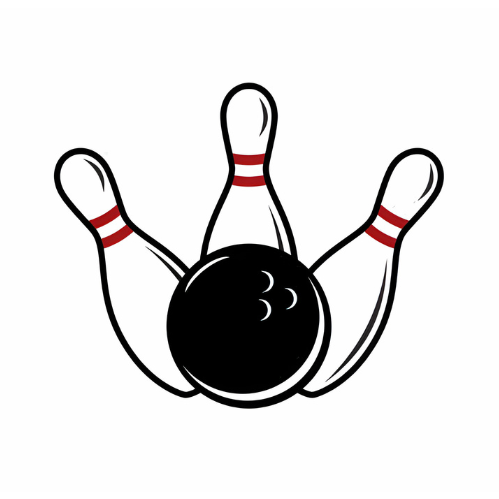To bleed a bowling ball, drill a small hole into the ball and allow the oil to seep out. Ensure the hole is properly sealed after the process.
Bowling enthusiasts often find themselves searching for techniques to maintain and enhance their ball’s performance. Bleeding a bowling ball is one such technique aimed at removing excess oil absorbed during play, which can significantly affect the ball’s traction and reactivity on the lane.
This upkeep is vital for bowlers who want to ensure their equipment functions optimally in every game. It’s essential to understand the correct method for this process to prevent damaging the ball. By following these steps, bowlers can restore their ball’s grip on the lane, leading to a more consistent and controlled game.

Credit: in.pinterest.com
Introduction To Ball Maintenance
Keeping a bowling ball in tip-top shape is crucial. Regular maintenance ensures peak performance during play. Just as a car needs an oil change, a bowling ball requires routine care. This care involves cleaning, sanding, and sometimes even more specialized tasks. By maintaining your bowling ball, you’ll enjoy a consistent bowling experience every time you hit the lanes.
Importance Of Bowling Ball Care
Maintaining your bowling ball can lead to better scores and a longer lifespan for the ball. Dirt, oil, and lane conditioners can build up over time, affecting the ball’s performance and reaction on the lane. Proper care allows for a clean surface and optimal interaction with the lane.
- Prevents damage to the ball’s surface
- Ensures consistent ball motion
- Extends ball longevity and usability
Bleeding: A Vital Part Of Routine Maintenance
Bleeding a bowling ball refers to the process of extracting oil from the ball’s pores. Over time, oil from the lanes soaks into the ball, causing it to react differently. This can lead to an unpredictable ball motion. By bleeding the ball, bowlers can restore the ball’s original surface properties and enhance its predictability. It’s a specialized maintenance step that can significantly improve your game.
- Cleans the ball’s microscopic pores
- Removes excess oil which impacts the ball’s traction
- Helps restore the ball to its original condition
Identifying The Need To Bleed
Bowling enthusiasts often forget a crucial aspect of their game: ball maintenance. Just like a car needs an oil change, a bowling ball requires bleeding. This process clears the ball of excess oil that it absorbs over time. Spotting when your ball needs this service can be a game-changer. Let’s dive into the signs that it’s time to bleed your ball.
Signs Your Bowling Ball Needs Attention
Keep an eye out for these clear indicators:
- Loss of Hook: Your ball doesn’t curve like it used to.
- Unpredictable Motion: The ball’s path becomes inconsistent.
- Oily Sheen: A visible layer of oil sits on the ball’s surface.
- Track Flaring: The oily track on the ball appears wider.
Impact Of Oil Absorption On Performance
Understanding oil absorption is key to optimal ball performance. As a ball rolls down the lane, it picks up oil, which affects how it moves. Too much oil causes the ball to skid, reducing its reaction to the pins. Below is a breakdown of how bleeding your ball helps:
| Aspect | Benefit of Bleeding |
|---|---|
| Friction | Increases grip on the lane |
| Hook Potential | Restores the ball’s curving capability |
| Consistency | Ensures reliable ball motion |
Essentials For Bleeding Your Bowling Ball
Essentials for Bleeding Your Bowling Ball – a process vital for maintaining peak performance. Bowling balls absorb oil over time, affecting the grip and hook potential. Regular bleeding is like a rejuvenation for your ball, ensuring a consistent reaction on the lanes. Get ready to roll up your sleeves; here’s how to set up for the task.
Tools And Materials
Before starting, gather the right tools and materials:
- Bowling ball cleaner – specifically designed for bleeding balls.
- Soft, clean towels – for wiping the surface.
- A ball holder – to keep the ball steady.
- Rubber gloves – to protect your hands.
- Bucket or container – to catch any drippings.
Setting Up Your Workspace
Choose a flat, clean area:
- Place your ball holder in the center.
- Line your bucket under the ball to catch excess cleaner.
- Don gloves to protect your skin from chemicals.
- Ensure adequate ventilation to avoid fume inhalation.

Credit: www.pinterest.com
Step-by-step Guide To Bleeding
Welcome to the Step-by-Step Guide to Bleeding a bowling ball. In this guide, we’ll cover the essential steps. If your bowling ball has lost its original performance, don’t worry. The process of bleeding or removing excess oil can help restore it. Follow these steps to ensure your bowling ball is ready to strike.
Cleaning The Surface
Start with a clean ball to remove dirt and oil from the surface. Use a bowling ball cleaner and a microfiber towel. Apply the cleaner onto the towel and wipe the ball in a circular motion. Repeat until the surface is oil-free.
The Heating Process
The next step involves gently heating the ball to expel the oil. Use a ball oven or a hairdryer. Keep the heat source moving to avoid damage to the ball. Check the ball’s temperature every 5 minutes.
Below is a simple guide on temperature and time:
| Temperature | Duration |
|---|---|
| Low (Ball Oven) | 60-90 mins |
| Medium (Hairdryer) | 15-20 mins |
Do not exceed the recommended time and be sure to maintain even heating.
Monitoring And Cool Down
After heating, it’s crucial to monitor the ball as it cools. Place the ball in a secure area where it can safely descend to room temperature. This should take about an hour. Once cooled, perform a final clean to ensure no residual oil remains. Your ball is now ready for action!
Aftercare And Maintenance Post-bleeding
The right aftercare for a bowling ball extends its life and preserves its condition. Once a bowling ball undergoes the bleeding process, it’s crucial to follow up with thorough cleaning. Regular maintenance keeps the ball at peak performance. Discover how to effectively clean and maintain your bowling ball post-bleeding with these simple tips.
Post-bleed Cleaning
Clean the ball immediately after bleeding it. This removes any oil risen to the surface. Here’s a step-by-step guide:
- Wipe the ball with a microfiber towel.
- Apply a ball cleaner approved for your bowling ball.
- Use the towel to rub the cleaner in a circular motion over the ball.
- Dry the ball thoroughly before storing.
Routine Maintenance Tips
Regular upkeep is key to a ball’s longevity. Follow these tips for optimal condition:
- Clean your ball after every session.
- Store the ball in a cool, dry place out of direct sunlight.
- Use a ball carrier to prevent damage during transport.
- Periodically take your ball to a pro shop for a deep clean and inspection.
| Interval | Task | Notes |
|---|---|---|
| After Each Use | Cleaning with towel & cleaner | Essential to remove lane oils |
| Monthly | Deep Clean | Recommended by a professional |
| Every 6 Months | Resurfacing | Restores ball’s original condition |
Fine-tuning Your Game
Are you ready to take your bowling skills to the next level? Bleeding your bowling ball can significantly enhance your game. Proper maintenance ensures optimal ball performance when you hit the lanes. Discover the steps to fine-tune your game for that perfect strike!
Adjusting To The Rejuvenated Ball
The feel of your ball changes after bleeding. Adjusting to your ball’s new condition is crucial.
- Check the weight distribution – Ensure the ball’s balance meets your style.
- Grip and release – Practice your grip. A fresh surface might alter your release.
- Ball reaction – Observe the movement. A cleaner ball has a different hooking pattern.
Adapt your techniques to match the revived ball dynamics. Embrace the changes to excel in your game.
Practicing Post-maintenance
Post-maintenance practice sessions are vital. They help you understand your ball’s new behavior. Utilize this time effectively:
- Start with light throws – Get a feel for the ball’s path and speed.
- Incremental adjustments – Make slight changes to your stance and swing.
- Record observations – Keep track of your ball’s performance.
- Seek feedback – Coaches or experienced players can offer valuable insights.
Commit to regular practice. This will help you synchronize with your bowling ball’s updated state.
| Date | Action | Observations | Adjustments |
|---|---|---|---|
| 04/01 | Bleed Ball | Faster down lane | Reduced speed |
| 04/02 | Practice | Better hook | Adjusted swing |
FAQ
Welcome to the insightful section on bowling ball maintenance specifically, the process known as “bleeding” a bowling ball. Here we address some of the most common questions about this crucial aspect of ball care. Let’s dive into frequently asked questions and expert guidance, ensuring your bowling ball performs at its best.
Common Concerns Addressed
Many bowlers have concerns about the necessity and safety of bleeding a bowling ball. Is it required for all balls? Can it damage your ball? We’ve got the answers.
- Bleeding is optional but beneficial for performance.
- It removes excess oil from the ball’s surface.
- Regular maintenance extends ball lifespan.
- Proper technique is crucial to avoid damage.
Expert Tips And Tricks
Seasoned bowlers recommend several tips for successful ball bleeding. These professional insights can help you get the most out of your equipment.
- Use a reputable ball cleaner to ensure thorough treatment.
- Perform bleeding in a controlled environment to avoid contaminants.
- Repeat the process every few months for consistent performance.
- Seek guidance from a pro shop if unsure of the process.
Conclusion
Mastering the process of bleeding a bowling ball is essential for maintaining peak performance on the lanes. With the right tools and techniques, you can ensure consistent, controlled play. Remember to follow safety procedures and consult with professionals if in doubt.
Keep striking and enjoy the game!

